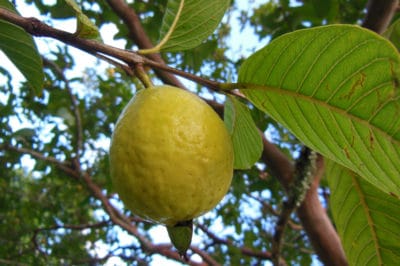Growing Guavas
Guavas aren’t difficult to grow if you have the right climate and some people are able to grow them in a sunroom or greenhouse. The tree may reach 20 feet. Make sure the tree has fertile, well-drained soil. Guavas need fertilizer at least every two months while young and three to four times a year after they are mature. Soil should be kept moist at all times during bloom and fruiting season.
Choosing a Guava Variety
Guava varieties differ in color and flavor. These are some possible choices:
- Tropical White– light yellow skin and white flesh
- Tropical Pink – very fragrant, pink flesh and yellow skin
- Mexican Cream – small, very sweet fruits
- Red Malaysian – red fruit and foliage, pink-red flesh
- Lemon – yellow flesh and fruit.
Maturity and Fruit
In the right conditions, guavas are one of the fruits you can harvest very quickly. Depending on the tree and variety, a guava can mature in as little as two years, although the average is three to four years. Weather may also make a difference – cool springs can delay blossoming and fruit development. Guavas are heavy producers – a single tree may produce 80 pounds of fruit.
Check the Color
Color change is an indicator of ripeness with most fruit and guava is no exception. Despite the names, red and pink guavas are picked when the peel turns from light green to yellow. These fruits are then ripened off the tree at room temperature. However, white guava is picked while still green to light green but it has reached full size. Once the fruit is soft and peel is yellow, it’s ready.
Texture Matters
The baseball-sized guava is nearly as hard as that ball when unripe. It softens as it begins to ripe. If you press gently on the rind of the fruit, you’ll feel the flesh give slightly. It may be a little more difficult to tell whether the fruit is softening when the guava is a thick-skinned variety. Once you’ve picked a few, you’ll have a better sense – an overripe guava can become mush very quickly, so check daily.
The Scent of a Guava
Once you’ve smelled a ripe guava, you will always know how to tell when the fruit is ripe. The scent becomes stronger as the fruit ripens and when the fruit is fully ripe, you’ll be able to smell it while still a little way away from the tree. A ripe guava is strongly aromatic, with what has been described as a sweet, musky and penetrating fragrance.
